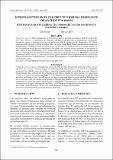Por favor, use este identificador para citar o enlazar este ítem:
https://hdl.handle.net/20.500.12958/4769| Título : | Ictioplancton en el Crucero de biomasa desovante de anchoveta 1908-09 |
| Otros títulos : | Ichthyoplankton during the 1908-09 cruise for anchoveta spawning biomass |
| Autor : | Pinedo, Elda Ayón Dejo, Patricia |
| Palabras clave : | Ictioplancton;Biomasa desovante;Anchoveta |
| Fecha de publicación : | jun-2022 |
| Editorial : | Instituto del Mar del Perú |
| Citación : | Pinedo, E., Ayón, P. (2022). Ictioplancton en el Crucero de biomasa desovante de anchoveta 1908-09. Inf Inst Mar Perú. 49(2): 296-302. |
| Citación : | Informe IMARPE 49(2), 2022; |
| Resumen : | Se presentan los resultados del análisis de muestras de ictioplancton recolectadas durante el crucero de biomasa desovante de anchoveta 1908-09 a bordo del BIC Humboldt y BIC Olaya, ejecutado del 26 de agosto al 25 de setiembre 2019, cubriendo el área desde Talara hasta bahía Independencia. Se determinó 27 especies de peces a nivel de larvas. Los huevos (715.360 huevos/m2) y larvas (111.100 larvas/m2) de anchoveta fueron los más abundantes y frecuentes con mayores desoves (huevos) localizados en la zona costera al norte de Malabrigo y en la zona oceánica entre Chimbote y Huacho, mientras que las larvas tuvieron importantes concentraciones dentro de la plataforma continental al norte de Malabrigo. Los huevos (35.680 huevos/m2) y larvas (3.220 larvas/m2) de vinciguerria también fueron importantes por sus densidades, distribuyéndose fuera de la plataforma continental. Otras especies que destacaron fueron los mictófidos y la familia Bathylagidae. ABSTRACT: Between August 26 and September 25, 2019, the Instituto del Mar del Perú (IMARPE) conducted the 1908-08 cruise for anchoveta spawning biomass, which covered the area from Talara to Independencia Bay, onboard the R/Vs Humboldt and Olaya. During the study period, we determined 27 species of fish at the larval stage. Eggs (715,360 eggs/m2) and larvae (111,100 larvae/m2) were the most abundant and frequent. For Engraulis ringens, the largest spawning (eggs) occurred north of Malabrigo, in the coastal zone, and the oceanic zone between Chimbote and Huacho, while the larvae had significant concentrations within the continental shelf north of Malabrigo. Vinciguerria lutetia was also important due to the densities of its eggs (35,680 eggs/m2) and larvae (3,220 larvae/m2, being distributed outside the continental shelf. Other species that stood out were the myctophids and the family Bathylagidae. |
| URI : | https://hdl.handle.net/20.500.12958/4769 |
| ISSN : | 0378-7702 |
| Aparece en las colecciones: | Informe vol. 49(2) 2022 |
Ficheros en este ítem:
| Fichero | Descripción | Tamaño | Formato | |
|---|---|---|---|---|
| Informe 49-2 artículo11.pdf | 663,02 kB | Adobe PDF |  Visualizar/Abrir |
Este ítem está sujeto a una licencia Creative Commons Licencia Creative Commons

